Solid-to-Liquid Ratio Influenced on Adhesion Strength of Metakaolin Geopolymer Coating Paste Added Photocatalyst Materials
Abstract
:1. Introduction
- Dissolution steps: The Si–O-Si and Si–O-Al bonds of the minerals are segmented, which results in the formation of reactive precursors (Si (OH)4 and Al (OH)4) in the solution.
- Restructuring steps: The reactive aluminosilicate precursors have the characteristics of being mobile and thermodynamically stable before being gelled.
- Polycondensation steps: The polymerization of oligo-sialate molecules, which was then followed by their reticulation and the development of a network of polysialate with the three-dimensional framework.
2. Experimental Methods
2.1. Materials
2.2. Mix Design and Preparation of Metakaolin Geopolymer Paste
2.3. Adhesion Strength Test
2.4. Water Absorption and Density Test
2.5. Microscopic Test
3. Results and Discussion
3.1. Adhesion Strength Analysis
3.2. Microstructure Analysis
3.3. Water Absorption and Density Analysis
4. Conclusions
Author Contributions
Funding
Institutional Review Board Statement
Informed Consent Statement
Data Availability Statement
Acknowledgments
Conflicts of Interest
References
- Mahmed, N.; Nor Saffirah Zailan, S.; Mustafa Al-Bakri Abdullah, M. Influence of TiO2 nanoparticles (wt%) onto the physical and mechanical properties of the TiO2-geopolymer paste. IOP Conf. Ser. Mater. Sci. Eng. 2020, 864, 012177. [Google Scholar] [CrossRef]
- Hamidi, F.; Aslani, F. TiO2-based photocatalytic cementitious composites: Materials, properties, influential parameters, and assessment techniques. Nanomaterials 2019, 9, 1444. [Google Scholar] [CrossRef] [PubMed] [Green Version]
- Andaloro, A.; Mazzucchelli, E.S.; Lucchini, A.; Pedeferri, M.P. Photocatalytic self-cleaning coatings for building facade maintenance. Performance analysis through a case-study application. J. Facade Des. Eng. 2017, 4, 115–129. [Google Scholar] [CrossRef] [Green Version]
- Jamaludin, L.; Razak, R.A.; Abdullah, M.M.A.B.; Vizureanu, P.; Bras, A.; Imjai, T.; Sandu, A.V.; Abd Rahim, S.Z.; Yong, H.C. The suitability of photocatalyst precursor materials in geopolymer coating applications: A review. Coatings 2022, 12, 1348. [Google Scholar] [CrossRef]
- Vitola, L.; Pundiene, I.; Pranckeviciene, J.; Bajare, D. The impact of the amount of water used in activation solution and the initial temperature of paste on the rheological behaviour and structural evolution of metakaolin-based geopolymer pastes. Sustainability 2020, 12, 8216. [Google Scholar] [CrossRef]
- Petroche, D.M.; Ramirez, A.D. The environmental profile of clinker, cement, and concrete: A life cycle perspective study based on Ecuadorian data. Buildings 2022, 12, 311. [Google Scholar] [CrossRef]
- Zhang, J.; Tian, B.; Wang, L.; Xing, M.; Lei, J. Mechanism of photocatalysis. In Photocatalysis. Fundamentals, Materials and Applications; Springer: Singapore, 2018. [Google Scholar]
- Luhar, I.; Luhar, S. A comprehensive review on fly ash-based geopolymer. J. Compos. Sci. 2022, 6, 219. [Google Scholar] [CrossRef]
- Kalaiyarrasi, A.R.R.; Partheeban, A.P. Influence of Si/Al ratio on the compressive strength of metakaolin based geopolymers. Int. J. Earth Sci. Eng. 2016, 9, 87–91. [Google Scholar]
- Faris, M.A.; Abdullah, M.M.A.B.; Muniandy, R.; Ramasamy, S.; Hashim, M.F.A.; Junaedi, S.; Sandu, A.V.; Mohd Tahir, M.F. Review on mechanical properties of metakaolin geopolymer concrete by inclusion of steel fibers. Arch. Metall. Mater. 2022, 67, 261–267. [Google Scholar]
- Burduhos Nergis, D.D.; Vizureanu, P.; Sandu, A.V.; Burduhos Nergis, D.P.; Bejinariu, C. XRD and TG-DTA study of new phosphate-based geopolymers with coal ash or metakaolin as aluminosilicate source and mine tailings addition. Materials 2021, 15, 202. [Google Scholar] [CrossRef]
- Zailani, W.W.A.; Abdullah, M.M.A.B.; Arshad, M.F.; Razak, R.A.; Tahir, M.F.M.; Zainol, R.R.M.A.; Nabialek, M.; Sandu, A.V.; Wysłocki, J.J.; Błoch, K. Characterisation at the bonding zone between fly ash based geopolymer repair materials (GRM) and ordinary Portland cement concrete (OPCC). Materials 2020, 14, 56. [Google Scholar] [CrossRef] [PubMed]
- Izzat, A.M.; Husin, K.; Abdullah, M.M.A.B.; Ghazali, C.M.R.; Tahir, M.F.M.; Sandu, A.V. Microstructural analysis of geopolymer and ordinary portland cement mortar exposed to sulfuric acid. Mater. Plast. 2013, 50, 171–174. [Google Scholar]
- Azimi, E.A.; Abdullah, M.M.A.B.; Vizureanu, P.; Salleh, M.A.A.M.; Sandu, A.V.; Chaiprapa, J.; Yoriya, S.; Hussin, K.; Aziz, I.H. Strength development and elemental distribution of dolomite/fly ash geopolymer composite under elevated temperature. Materials 2020, 13, 1015. [Google Scholar] [CrossRef]
- Burduhos Nergis, D.D.; Vizureanu, P.; Corbu, O. Synthesis and characteristics of local fly ash based geopolymers mixed with natural aggregates. Rev. Chim. 2019, 70, 1262–1267. [Google Scholar] [CrossRef]
- Burduhos Nergis, D.D.; Abdullah, M.M.A.B.; Vizureanu, P.; Tahir, M.F.M. Geopolymers and their uses: Review. IOP Conf. Ser. Mater. Sci. Eng. 2018, 374, 012019. [Google Scholar] [CrossRef]
- Shahedan, N.F.; Abdullah, M.M.A.B.; Mahmed, N.; Kusbiantoro, A.; Tammas-Williams, S.; Li, L.-Y.; Aziz, I.H.; Vizureanu, P.; Wysłocki, J.J.; Błoch, K.; et al. Properties of a new insulation material glass bubble in geopolymer concrete. Materials 2021, 14, 809. [Google Scholar] [CrossRef]
- Bai, Y.; Guo, W.; Wang, X.; Pan, H.; Zhao, Q.; Wang, D. Utilization of municipal solid waste incineration fly ash with red mud-carbide slag for eco-friendly geopolymer preparation. J. Clean. Prod. 2022, 340, 130820. [Google Scholar] [CrossRef]
- Luhar, S.; Luhar, I. Application of seawater and sea sand to develop geopolymer composites. Int. J. Recent Technol. Eng. (IJRTE) 2020, 8, 5625–5633. [Google Scholar] [CrossRef]
- Azad, N.M.; Samarakoon, S.M.S.M.K. Utilization of industrial by-products/waste to manufacture geopolymer cement/concrete. Sustainability 2021, 13, 873. [Google Scholar] [CrossRef]
- Wang, L.; Geddes, D.A.; Walkley, B.; Provis, J.L.; Mechtcherine, V.; Tsang, D.C.W. The role of zinc in metakaolin-based geopolymers. Cem. Concr. Res. 2020, 136, 106194. [Google Scholar] [CrossRef]
- Yao, X.; Zhang, Z.; Zhu, H.; Chen, Y. Geopolymerization process of alkali–metakaolinite characterized by isothermal calorimetry. Thermochim. Acta 2009, 493, 49–54. [Google Scholar] [CrossRef]
- Jindal, B.B.; Alomayri, T.; Hasan, A.; Kaze, C.R. Geopolymer concrete with metakaolin for sustainability: A comprehensive review on raw material’s properties, synthesis, performance, and potential application. Environ. Sci. Pollut. Res. 2022. [Google Scholar] [CrossRef]
- Toniolo, N.; Rincón, A.; Avadhut, Y.S.; Hartmann, M.; Bernardo, E.; Boccaccini, A.R. Novel geopolymers incorporating red mud and waste glass cullet. Mater. Lett. 2018, 219, 152–154. [Google Scholar] [CrossRef]
- Guzmán-Aponte, L.A.; de Gutiérrez, R.M.; Maury-Ramírez, A. Metakaolin-based geopolymer with added TiO2 particles: Physicomechanical characteristics. Coatings 2017, 7, 233. [Google Scholar] [CrossRef] [Green Version]
- Irfan Khan, M.; Azizli, K.; Sufian, S.; Man, Z. Sodium silicate-free geopolymers as coating materials: Effects of Na/Al and water/solid ratios on adhesion strength. Ceram. Int. 2015, 41, 2794–2805. [Google Scholar] [CrossRef]
- Nochaiya, T.; Sekine, Y.; Choopun, S.; Chaipanich, A. Microstructure, characterizations, functionality and compressive strength of cement-based materials using zinc oxide nanoparticles as an additive. J. Alloy. Compd 2015, 630, 1–10. [Google Scholar] [CrossRef]
- Garg, N.; White, C.E. Mechanism of zinc oxide retardation in alkali-activated materials: An in situ X-ray pair distribution function investigation. J. Mater. Chem. A Mater. 2017, 5, 11794–11804. [Google Scholar] [CrossRef]
- Jiang, C.; Wang, A.; Bao, X.; Chen, Z.; Ni, T.; Wang, Z. Protective geopolymer coatings containing multi-componential precursors: Preparation and basic properties characterization. Materials 2020, 13, 3448. [Google Scholar] [CrossRef]
- Dilik, T.; Erdinler, S.; Hazir, E.; Koç, H.; Hiziroglu, S. Adhesion strength of wood based composites coated with cellulosic and polyurethane paints. Adv. Mater. Sci. Eng. 2015, 2015, 745675. [Google Scholar] [CrossRef] [Green Version]
- Basri, M.S.M.; Mustapha, F.; Mazlan, N.; Ishak, M.R. Optimization of adhesion strength and microstructure properties by using response surface methodology in enhancing the rice husk ash-based geopolymer composite coating. Polymers 2020, 12, 2709. [Google Scholar] [CrossRef]
- Ramasamy, S.; Hussin, K.; Abdullah, M.M.A.B.; Ghazali, C.M.R.; Binhussain, M.; Sandu, A.V. Interrelationship of kaolin, alkaline liquid ratio and strength of kaolin geopolymer. IOP Conf. Ser. Mater. Sci. Eng. 2016, 133, 012004. [Google Scholar] [CrossRef] [Green Version]
- Gao, X.; Yu, Q.L.; Brouwers, H.J.H. Characterization of alkali activated slag–fly ash blends containing nano-silica. Constr. Build. Mater. 2015, 98, 397–406. [Google Scholar] [CrossRef]
- Wan, Q.; Rao, F.; Song, S.; Zhang, Y. Immobilization forms of ZnO in the solidification/stabilization (S/S) of a zinc mine tailing through geopolymerization. J. Mater. Res. Technol. 2019, 8, 5728–5735. [Google Scholar] [CrossRef]
- Kara, İ.; Yilmazer, D.; Akar, S.T. Metakaolin based geopolymer as an effective adsorbent for adsorption of zinc(II) and nickel(II) ions from aqueous solutions. Appl. Clay Sci. 2017, 139, 54–63. [Google Scholar] [CrossRef]
- Essawy, A.A.; Abd, S. Physico-mechanical properties, potent adsorptive and photocatalytic efficacies of sulfate resisting cement blends containing micro silica and nano-TiO2. Constr. Build. Mater. 2014, 52, 1–8. [Google Scholar] [CrossRef]
- Rong, X.; Wang, Z.; Xing, X.; Zhao, L. Review on the adhesion of geopolymer coatings. ACS Omega 2021, 6, 5108–5112. [Google Scholar] [CrossRef]
- Bhardwaj, P.; Gupta, R.; Mishra, D.; Sanghi, S.K.; Verma, S.; Amritphale, S.S. Corrosion and fire protective behavior of advanced phosphatic geopolymeric coating on mild steel substrate. Silicon 2020, 12, 487–500. [Google Scholar] [CrossRef]
- De Gutiérrez, R.M.; Villaquirán-Caicedo, M.; Ramírez-Benavides, S.; Astudillo, M.; Mejía, D. Evaluation of the antibacterial activity of a geopolymer mortar based on metakaolin supplemented with TiO2 and CuO particles using glass waste as fine aggregate. Coatings 2020, 10, 157. [Google Scholar] [CrossRef] [Green Version]
- Sorathiya, J.; Shah, S.; Smit Kacha, M.; Modhera, C.D.; Joshi, G.J.; Soni, D.; Patel, I.N.; Verma, A.K.; Zala, L.B.; Dhiman, S.D.; et al. Effect on addition of nano “titanium dioxide” (TiO2) on compressive strength of cementitious concrete civil engineering. In Proceedings of the International Conference on Research and Innovations in Science, Engineering and Technology, Meerut, India, 26–27 August 2017; Volume 1. [Google Scholar]
- Li, Z.; Han, B.; Yu, X.; Dong, S.; Zhang, L.; Dong, X.; Ou, J. Effect of nano-titanium dioxide on mechanical and electrical properties and microstructure of reactive powder concrete. Mater. Res. Express. 2017, 4, 095008. [Google Scholar] [CrossRef]
- Rodríguez, E.D.; Bernal, S.A.; Provis, J.L.; Gehman, J.D.; Monzó, J.M.; Payá, J.; Borrachero, M.V. Geopolymers based on spent catalyst residue from a fluid catalytic cracking (FCC) process. Fuel 2013, 109, 493–502. [Google Scholar] [CrossRef]
- Wang, J.; Du, P.; Zhou, Z.; Xu, D.; Xie, N.; Cheng, X. Effect of nano-silica on hydration, microstructure of alkali-activated slag. Constr. Build. Mater. 2019, 220, 110–118. [Google Scholar] [CrossRef]
- Alomayri, T. Experimental study of the microstructural and mechanical properties of geopolymer paste with nano material (Al2O3). J. Build. Eng. 2019, 25, 100788. [Google Scholar] [CrossRef]
- Barbhuiya, S.; Mukherjee, S.; Nikraz, H. Effects of nano-Al2O3 on early-age microstructural properties of cement paste. Constr. Build. Mater. 2014, 52, 189–193. [Google Scholar] [CrossRef]
- Nivethitha, D.; Dharmar, S. Influence of zinc oxide nanoparticle on strength and durability of cement mortar. Int. J. Earth Sci. Eng. 2016, 9, 175–181. [Google Scholar]
- Deshmukh, K.; Parsai, R.; Anshul, A.; Singh, A.; Bharadwaj, P.; Gupta, R.; Mishra, D.; Sitaram Amritphale, S. Studies on fly ash based geopolymeric material for coating on mild steel by paint brush technique. Int. J. Adhes. Adhes. 2017, 75, 139–144. [Google Scholar] [CrossRef]
- Mustapha, S.; Ndamitso, M.M.; Abdulkareem, A.S.; Tijani, J.O.; Shuaib, D.T.; Ajala, A.O.; Mohammed, A.K. Application of TiO2 and ZnO nanoparticles immobilized on clay in wastewater treatment: A review. Appl. Water Sci. 2020, 10, 49. [Google Scholar] [CrossRef] [Green Version]
- Mohd Azhar, N.S.D.; Zainal, F.F.; Abdullah, M.M.A.B. Effect of different ratio of geopolymer paste based fly ash-metakaolin on compressive strength and water absorption. IOP Conf. Ser. Mater. Sci. Eng. 2019, 701, 012010. [Google Scholar] [CrossRef]
- Ambikakumari Sanalkumar, K.U.; Yang, E.H. Self-cleaning performance of nano-TiO2 modified metakaolin-based geopolymers. Cem. Concr. Compos. 2021, 115, 103847. [Google Scholar] [CrossRef]
- Zidi, Z.; Ltifi, M.; ben Ayadi, Z.; Mir, L.E.L.; Nóvoa, X.R. Effect of nano-ZnO on mechanical and thermal properties of geopolymer. J. Asian Ceram. Soc. 2020, 8, 1–9. [Google Scholar] [CrossRef] [Green Version]
- Paleu, C.C.; Munteanu, C.; Istrate, B.; Bhaumik, S.; Vizureanu, P.; Bălţatu, M.S.; Paleu, V. Microstructural analysis and tribological behavior of AMDRY 1371 (Mo–NiCrFeBSiC) atmospheric plasma spray deposited thin coatings. Coatings 2020, 10, 1186. [Google Scholar] [CrossRef]
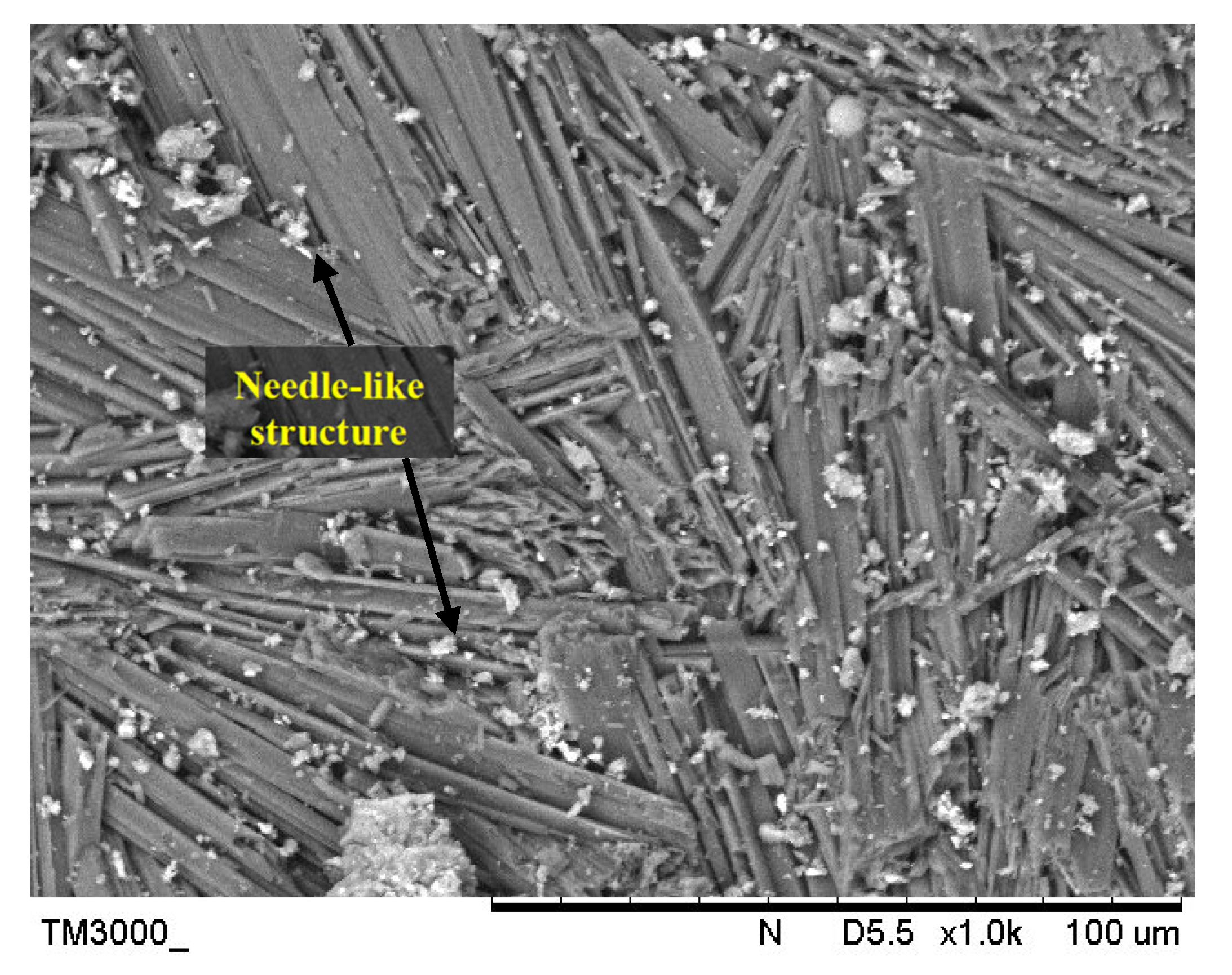


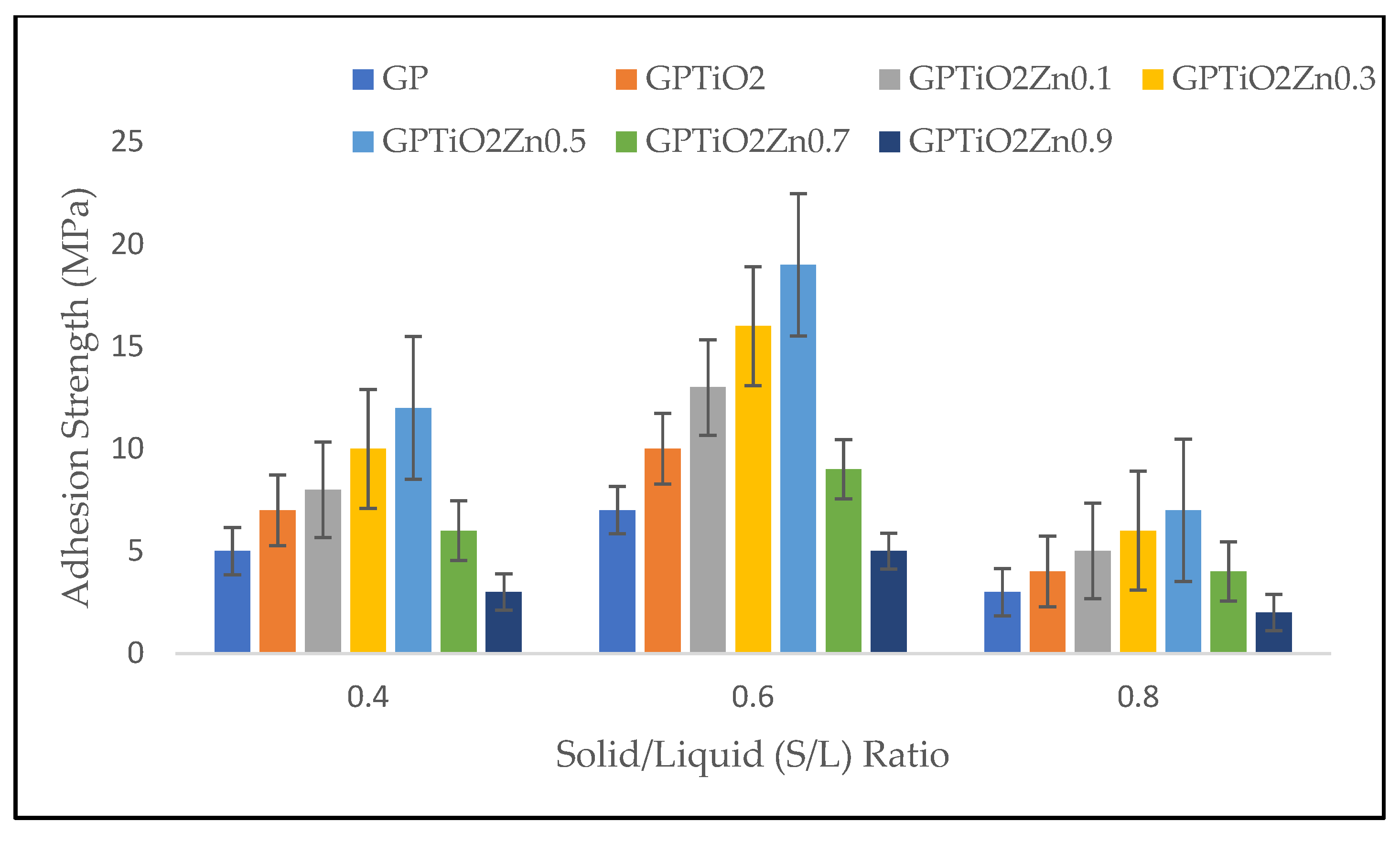
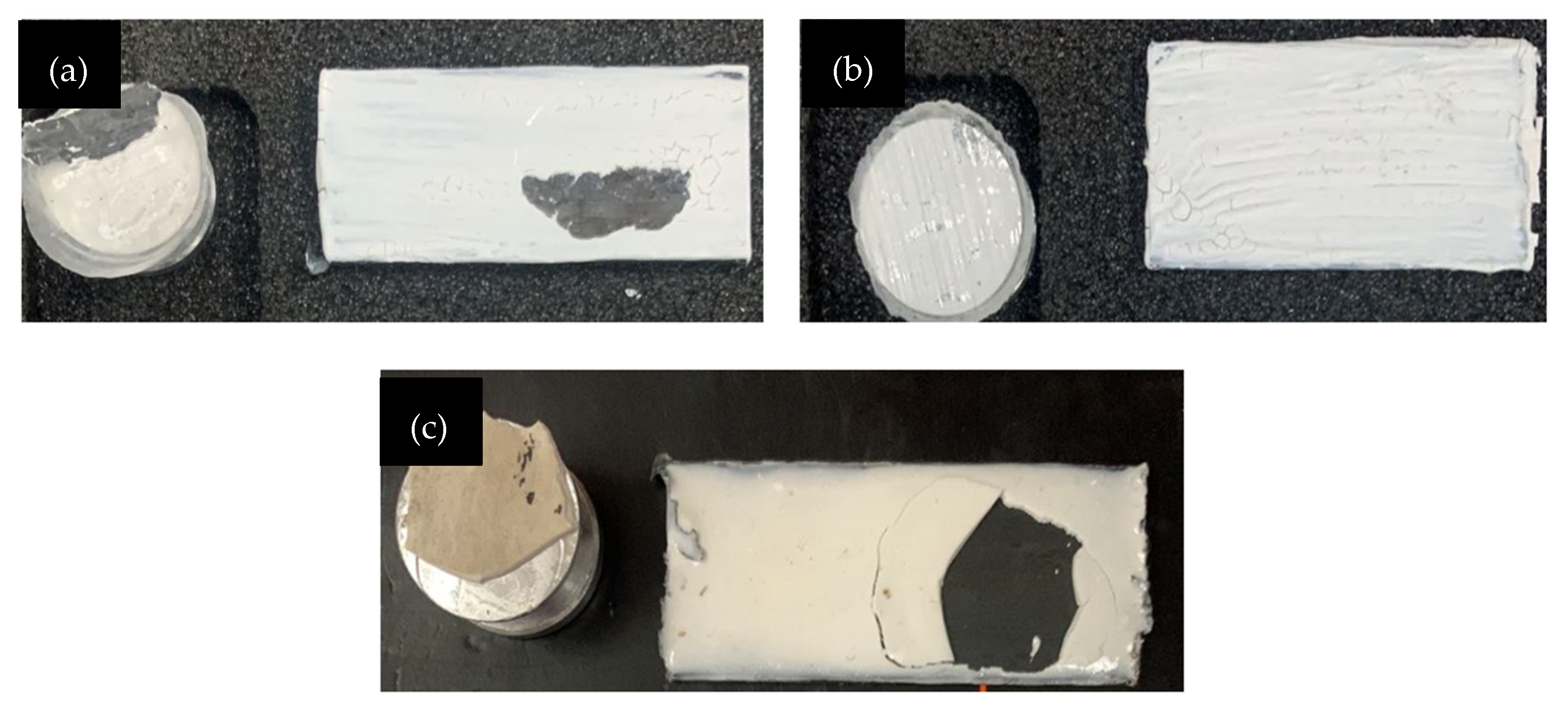
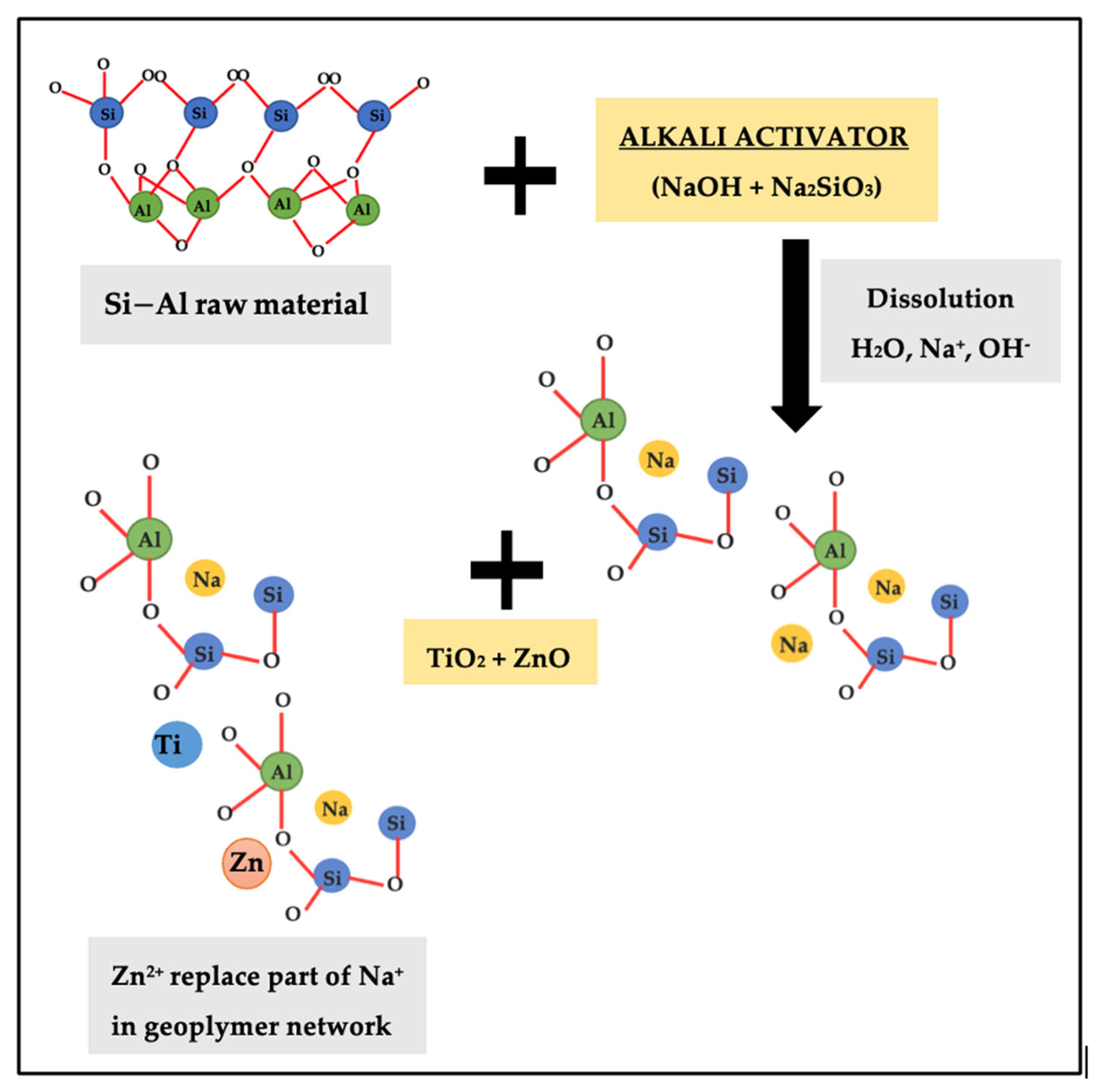
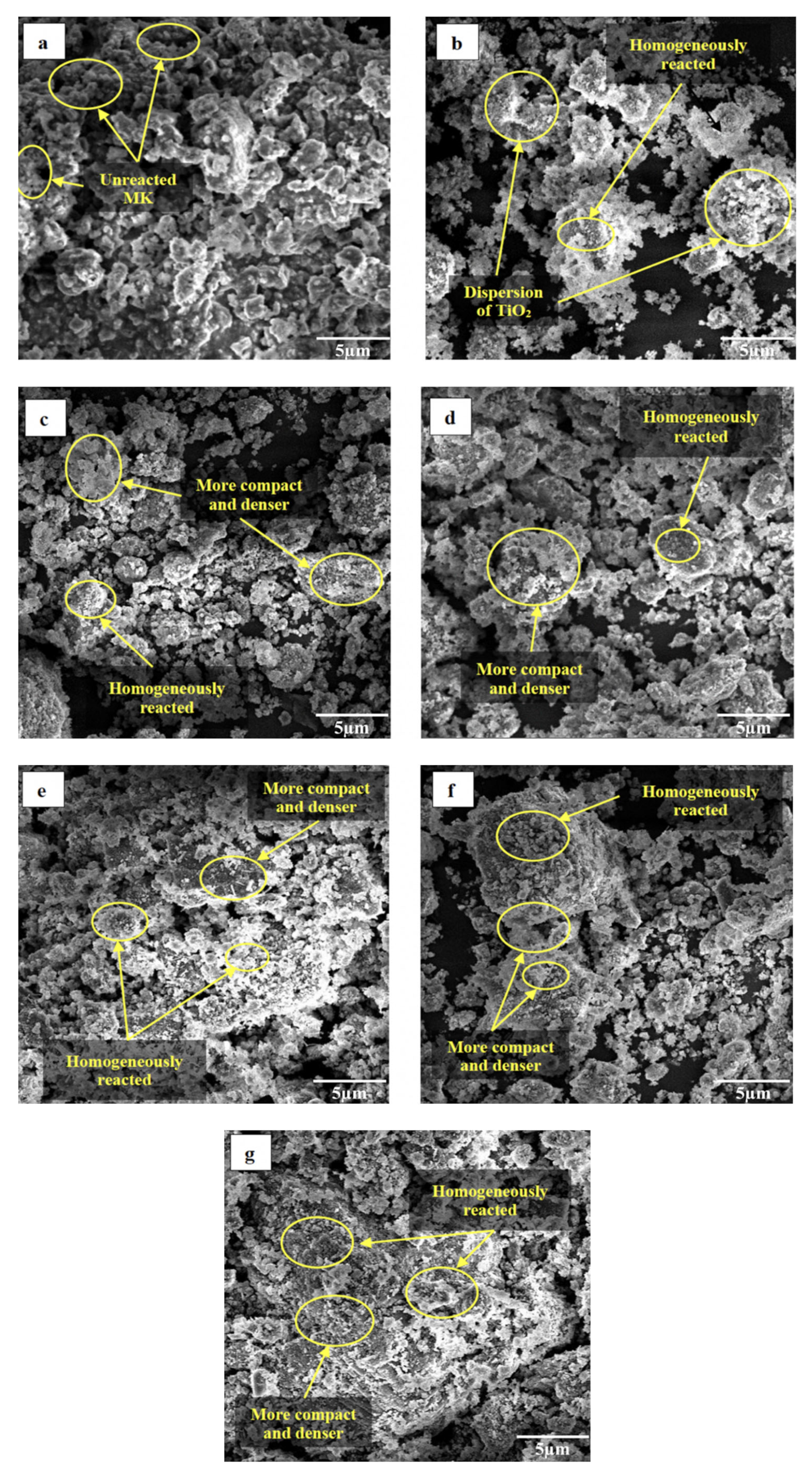
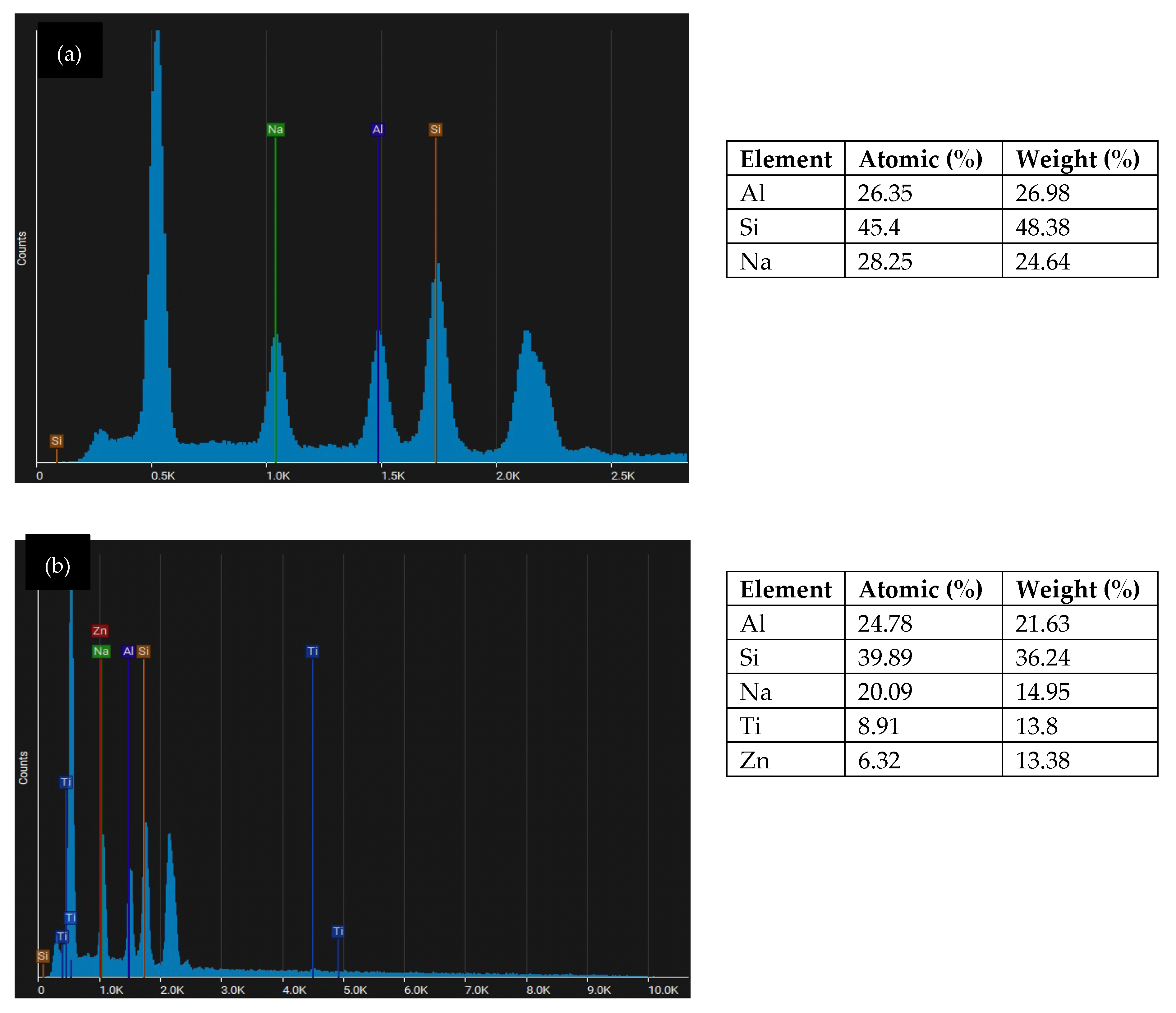
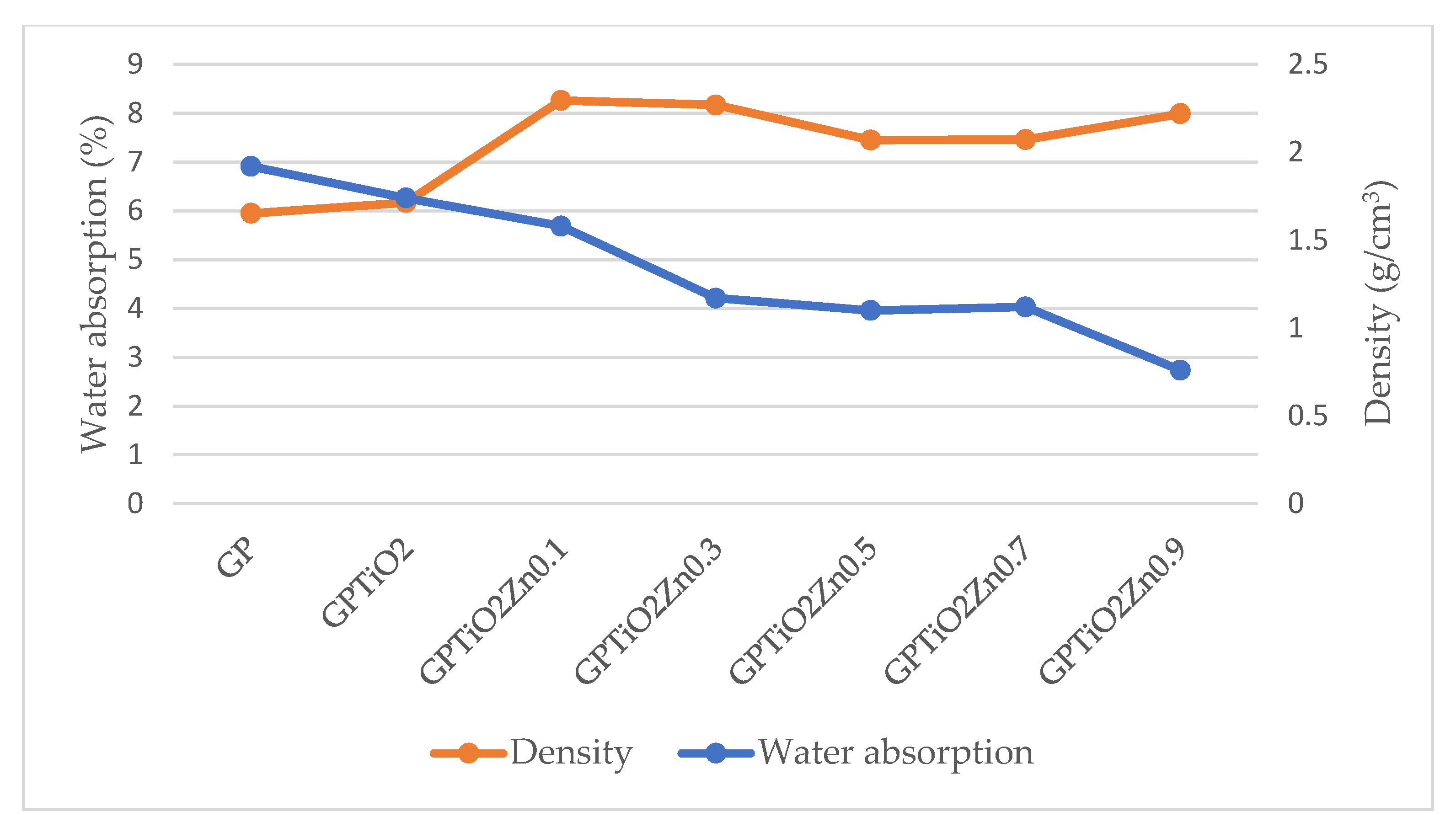
| Mix | S/L | Metakaolin (g) | Alkali Activator (g) | TiO2 (wt.%) | ZnO (wt.%) |
|---|---|---|---|---|---|
| 1 | 0.4 | 107 | 267.5 | - | - |
| 2 | 0.4 | 107 | 267.5 | 5 | - |
| 3 | 0.4 | 107 | 267.5 | 5 | 0.1 |
| 4 | 0.4 | 107 | 267.5 | 5 | 0.3 |
| 5 | 0.4 | 107 | 267.5 | 5 | 0.5 |
| 6 | 0.4 | 107 | 267.5 | 5 | 0.7 |
| 7 | 0.4 | 107 | 267.5 | 5 | 0.9 |
| 8 | 0.6 | 93.8 | 156.3 | - | - |
| 9 | 0.6 | 93.8 | 156.3 | 5 | - |
| 10 | 0.6 | 93.8 | 156.3 | 5 | 0.1 |
| 11 | 0.6 | 93.8 | 156.3 | 5 | 0.3 |
| 12 | 0.6 | 93.8 | 156.3 | 5 | 0.5 |
| 13 | 0.6 | 93.8 | 156.3 | 5 | 0.7 |
| 14 | 0.6 | 93.8 | 156.3 | 5 | 0.9 |
| 15 | 0.8 | 83.3 | 104.1 | - | - |
| 16 | 0.8 | 83.3 | 104.1 | 5 | - |
| 17 | 0.8 | 83.3 | 104.1 | 5 | 0.1 |
| 18 | 0.8 | 83.3 | 104.1 | 5 | 0.3 |
| 19 | 0.8 | 83.3 | 104.1 | 5 | 0.5 |
| 20 | 0.8 | 83.3 | 104.1 | 5 | 0.7 |
| 21 | 0.8 | 83.3 | 104.1 | 5 | 0.9 |
| Mix | Water Absorption (%) | Density (g/cm3) | Specific Gravity |
|---|---|---|---|
| GP | 1.92 | 5.95 | 6.951 |
| GPTiO2 | 1.74 | 6.17 | 6.919 |
| GPTiO2Zn0.1 | 1.58 | 8.26 | 6.420 |
| GPTiO2Zn0.3 | 1.17 | 8.17 | 7.129 |
| GPTiO2Zn0.5 | 1.1 | 7.45 | 7.345 |
| GPTiO2Zn0.7 | 1.12 | 7.46 | 7.346 |
| GPTiO2Zn0.9 | 0.76 | 7.99 | 7.055 |
Disclaimer/Publisher’s Note: The statements, opinions and data contained in all publications are solely those of the individual author(s) and contributor(s) and not of MDPI and/or the editor(s). MDPI and/or the editor(s) disclaim responsibility for any injury to people or property resulting from any ideas, methods, instructions or products referred to in the content. |
© 2023 by the authors. Licensee MDPI, Basel, Switzerland. This article is an open access article distributed under the terms and conditions of the Creative Commons Attribution (CC BY) license (https://creativecommons.org/licenses/by/4.0/).
Share and Cite
Jamaludin, L.; Razak, R.A.; Al Bakri Abdullah, M.M.; Vizureanu, P.; Sandu, A.V.; Abd Rahim, S.Z.; Ahmad, R. Solid-to-Liquid Ratio Influenced on Adhesion Strength of Metakaolin Geopolymer Coating Paste Added Photocatalyst Materials. Coatings 2023, 13, 236. https://doi.org/10.3390/coatings13020236
Jamaludin L, Razak RA, Al Bakri Abdullah MM, Vizureanu P, Sandu AV, Abd Rahim SZ, Ahmad R. Solid-to-Liquid Ratio Influenced on Adhesion Strength of Metakaolin Geopolymer Coating Paste Added Photocatalyst Materials. Coatings. 2023; 13(2):236. https://doi.org/10.3390/coatings13020236
Chicago/Turabian StyleJamaludin, Liyana, Rafiza Abd Razak, Mohd Mustafa Al Bakri Abdullah, Petrica Vizureanu, Andrei Victor Sandu, Shayfull Zamree Abd Rahim, and Romisuhani Ahmad. 2023. "Solid-to-Liquid Ratio Influenced on Adhesion Strength of Metakaolin Geopolymer Coating Paste Added Photocatalyst Materials" Coatings 13, no. 2: 236. https://doi.org/10.3390/coatings13020236










